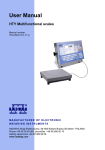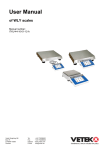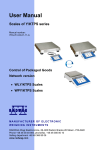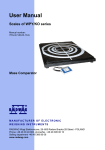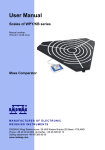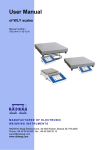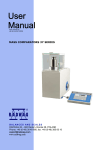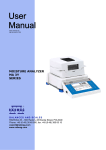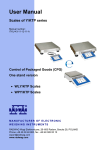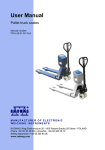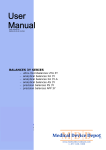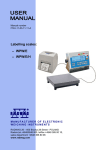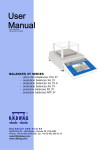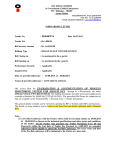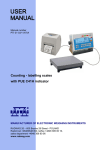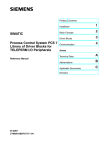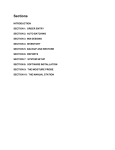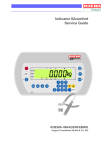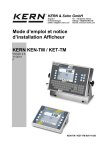Download User Manual of WAD scales
Transcript
User Manual of WAD 1/A4 scales Manual number: ITKU-62-07-12-11-A Automatic batching scale MANUFACTURER OF ELECTRONIC WEIGHING INSTRUMENTS RADWAG Wagi Elektroniczne, 26–600 Radom, Bracka 28, POLAND Phone +48 48 38 48 800, fax. +48 48 385 00 10 [email protected] www.radwag.com DECEMBER 2011 2 Table OF CONTENTS 1. INTENDED USE .............................................................................................................................................6 2. PRECAUTIONARY MEASURES....................................................................................................................6 2.1. Operation..................................................................................................................................................6 2.2. Operation in a strong electrostatic field.....................................................................................................6 3. WARRANTY CONDITIONS............................................................................................................................7 4. CONSTRUCTION AND PRINCIPLE OF OPERATION...................................................................................8 5. DESCRIPTION OF CONNECTORS ...............................................................................................................9 5.1. Connectors’ description ............................................................................................................................9 5.2. Description of glands ................................................................................................................................9 5.3. Connector with RS232 and I/O ...............................................................................................................10 6. GETTING STARTED ....................................................................................................................................10 7. KEYPAD OVERLAY.....................................................................................................................................11 8. FUNCTIONS OF KEYS ................................................................................................................................11 9. PROGRAM STRUCTURE ............................................................................................................................12 9.1. Main menu items ....................................................................................................................................12 9.2. Inventory of parameters..........................................................................................................................13 9.2.1. Scale parameters - weighing .....................................................................................................13 9.2.2. Working modes..........................................................................................................................13 9.2.3. Communication..........................................................................................................................13 9.2.4. Devices......................................................................................................................................14 9.2.5. Display.......................................................................................................................................16 9.2.6. Inputs / Outputs .........................................................................................................................17 9.2.7. Authorizations ............................................................................................................................18 9.2.8. Units ..........................................................................................................................................18 9.2.9. Other .........................................................................................................................................19 9.2.10. User Calibration .........................................................................................................................19 9.2.11. Info ............................................................................................................................................19 10. INDICATING WINDOW ..............................................................................................................................20 11. LOGGING IN ..............................................................................................................................................21 11.1. Logging in procedure............................................................................................................................21 11.2. Logging out procedure..........................................................................................................................22 11.3. Authorization access levels ..................................................................................................................22 12. NAVIGATING WITHIN THE MENU ............................................................................................................23 12.1. Keys .....................................................................................................................................................23 12.2. Return to weighing................................................................................................................................24 13. SCALE PARAMETERS..............................................................................................................................25 13.1. Median filter..........................................................................................................................................25 13.2. Filter .....................................................................................................................................................26 13.3. Autozero...............................................................................................................................................26 13.4. Minimum weight for different functions (LO) .........................................................................................27 13.5. Last digit ...............................................................................................................................................27 14. COMMUNICATION.....................................................................................................................................28 14.1. RS 232 settings ....................................................................................................................................28 14.2. ETHERNET setting...............................................................................................................................28 14.3. TCP protocol setting .............................................................................................................................29 15. DEVICES ....................................................................................................................................................29 15.1. Computer..............................................................................................................................................29 15.1.1. Computer port............................................................................................................................30 15.1.2. Computer address .....................................................................................................................30 15.1.3. Continuous transmission............................................................................................................30 15.1.4. Weighing printout template ........................................................................................................31 15.1.5. Cooperation with „E2R System”.................................................................................................32 15.2. Printer...................................................................................................................................................32 15.2.1. Printer port.................................................................................................................................33 15.2.2. Printer code page ......................................................................................................................33 15.2.3. Templates for printouts ..............................................................................................................33 15.3. Barcode scanner ..................................................................................................................................35 15.3.1. Port for barcode scanner ...........................................................................................................35 15.3.2. Prefix / Suffix .............................................................................................................................36 3 15.3.3. Field selection............................................................................................................................36 15.3.4. Test ...........................................................................................................................................38 15.4. Transponder card reader ......................................................................................................................38 15.4.1. Com port for transponder card readers ......................................................................................39 15.4.2. Procedure of attributing the card number to an operator............................................................39 15.5. Additional display..................................................................................................................................40 15.5.1. Additional display port................................................................................................................40 15.5.2. Communication protocol frame ..................................................................................................40 16. DISPLAY ....................................................................................................................................................41 16.1. Text strings...........................................................................................................................................41 16.1.1. Display templates ......................................................................................................................42 16.1.2. Screen font ................................................................................................................................43 16.1.3. Font size ....................................................................................................................................43 16.1.4. Bold fonts...................................................................................................................................43 16.2. Function keys .......................................................................................................................................44 16.3. Displaying platforms .............................................................................................................................44 16.4. Bargraph type.......................................................................................................................................45 16.4.1. Bargraf “Quick weighing” ...........................................................................................................46 16.4.2. Bargraph “Signalling checkweighing ranges” .............................................................................46 16.4.3. Bargraph „Linear”.......................................................................................................................47 17. INPUTS / OUTPUTS...................................................................................................................................47 17.1. Configuration of inputs..........................................................................................................................48 17.2. Configuration of outputs .......................................................................................................................48 18. AUTHORIZATION ......................................................................................................................................49 18.1. Anonymous Operator ...........................................................................................................................49 18.2. Date and time .......................................................................................................................................50 18.3. Printouts ...............................................................................................................................................50 18.4. Databases ............................................................................................................................................51 18.5. Delete older data ..................................................................................................................................51 19. UNITS.........................................................................................................................................................52 19.1. Start unit...............................................................................................................................................52 19.2. User defined units.................................................................................................................................53 19.3. Acceleration of gravity ..........................................................................................................................53 20. OTHER PARAMETERS .............................................................................................................................54 20.1. Languages............................................................................................................................................54 20.2. Setting date and time............................................................................................................................54 20.3. Sound signal.........................................................................................................................................55 20.4. Cursor ..................................................................................................................................................55 20.5. Touch panel calibration ........................................................................................................................55 21. USER ADJUSTMENT ................................................................................................................................56 21.1. Adjusting procedure..............................................................................................................................56 21.2. Start mass adjustment..........................................................................................................................58 21.3. Report from adjustment process...........................................................................................................58 21.4. Adjustment track record........................................................................................................................59 22. WORKING MODE – VIBRATORY BATCHER ...........................................................................................60 22.1. Setting parameters of working modes ..................................................................................................60 22.1.1. Chute permission mode .............................................................................................................60 22.1.2. Number of weighings for calculating the correction....................................................................61 22.2. Statistics...............................................................................................................................................61 22.3. Starting of dosing process ....................................................................................................................62 22.4. Dosing process.....................................................................................................................................63 23. DATABASES .............................................................................................................................................65 23.1. Searching databases............................................................................................................................65 23.1.1. Quick name search....................................................................................................................66 23.1.2. Quick code search .....................................................................................................................66 23.1.3. Weighing date search ................................................................................................................66 23.2. Adding new items in databases ............................................................................................................67 23.3. Deleting items in databases..................................................................................................................67 23.4. Deleting older data ...............................................................................................................................68 23.5. Printing items from databases ..............................................................................................................68 23.6. Export a database to a file ....................................................................................................................69 23.7. Database edition ..................................................................................................................................70 4 23.7.1. Operators’ database ..................................................................................................................70 23.7.2. Database of products.................................................................................................................70 23.7.3. Database of Weighings / Alibi ....................................................................................................72 23.7.4. Database of clients ....................................................................................................................73 23.7.5. Database of formulas.................................................................................................................74 23.7.6. Database of reports from formulation.........................................................................................74 23.7.7. Database of density ...................................................................................................................75 23.7.8. Database of packages ...............................................................................................................76 23.7.9. Database of warehouses ...........................................................................................................76 23.7.10. Database of labels...................................................................................................................77 23.7.11. Database of universal variables...............................................................................................78 24. COMMUNICATION PROTOCOL................................................................................................................78 24.1. General information ..............................................................................................................................78 24.2. Inventory of RS commands ..................................................................................................................79 24.3. Respond message format.....................................................................................................................79 24.4. Command’s description ........................................................................................................................80 24.4.1. Zeroing ......................................................................................................................................80 24.4.2. Tarring .......................................................................................................................................80 24.4.3. Get tare value ............................................................................................................................81 24.4.4. Set tare value ............................................................................................................................81 24.4.5. Send the stable result in basic unit ............................................................................................82 24.4.6. Send the result immediately in basic unit ...................................................................................82 24.4.7. Send immediate results from all platforms in basic units............................................................83 24.4.8. Send the stable result in current unit..........................................................................................83 24.4.9. Send the result immediately in current unit ................................................................................84 24.4.10. Switch on continuous transmission in basic unit ......................................................................85 24.4.11. Switch off continuous transmission in basic unit ......................................................................85 24.4.12. Switch on continuous transmission in current unit ...................................................................85 24.4.13. Switch off continuous transmission in current unit ...................................................................86 24.4.14. Set lower threshold..................................................................................................................86 24.4.15. Set upper threshold .................................................................................................................86 24.4.16. Read lower threshold...............................................................................................................86 24.4.17. Read upper threshold ..............................................................................................................87 24.4.18. Send all implemented commands............................................................................................87 24.5. Manual printouts / automatic printouts ..................................................................................................87 25. COOPERATION WITH EXTERNAL DEVICES...........................................................................................88 26. DIAGRAMS OF CONNECTION CABLES ..................................................................................................88 27. TECHNICAL PARAMETERS .....................................................................................................................90 28. ERROR MESSAGES..................................................................................................................................90 29. ADDITIONAL EQUIPMENT........................................................................................................................90 30. APPENDIX A – Variables for printouts ....................................................................................................91 30.1. Inventory of variables ...........................................................................................................................91 30.2. Formatting variables .............................................................................................................................96 31. APPENDIX B – Functions of programmable buttons .............................................................................98 32. APPENDIX C – Label template ...............................................................................................................102 32.1. Designing a label from the terminal level ............................................................................................102 32.2. Designing a label on a computer ........................................................................................................103 32.3. Saving label templates in the scale.....................................................................................................107 32.4. Attributing a label to a product ............................................................................................................107 32.5. Attributing a label to a client................................................................................................................108 32.6. Printing labels.....................................................................................................................................108 33. APPENDIX D - CITIZEN printer setting ..................................................................................................108 34. APPENDIX E - ZEBRA printer setting ....................................................................................................109 35. APPENDIX F - Communication with barcode scanners .......................................................................109 5 1. INTENDED USE WAD vibratory batchers are intended for multiline dosing loose and granulated materials. Typical materials: salt, sugar, grain, flour, spices, coffee, tea, beans, rice, dried fruits and other loose, granulated, frozen products. The state-of-the-art weighing terminal with TFT 5.7” colour graphic displays with touch panels allows for intuitive operation without using keys. Scales are equipped with 2 USB interfaces, 2 RS232 connectors, port Ethernet and 4 inputs/4 outputs (digital). They can cooperate with barcode scanners, receipt printers, label printers, transponder card readers (RFID) and standard PC equipment: mouse, keyboard, pendrives (limited use). 2. PRECAUTIONARY MEASURES 2.1. Operation A. Please, read carefully this user manual before and use the device according to its intended use; B. To use the touch panel do not use sharp tools (e.g., knife, screwdriver, etc.); C. The use in potentially explosive areas or surrounded by harmful gases, vapours, dust, radiation or close to acids is forbidden; D. It is forbidden to run and use the weight of damaged; E. Work on the device for installation, running and maintenance may be performed only by qualified persons properly trained in operating the scale and current health and safety regulations; F. Devices that are to be withdrawn from usage should be utilized according to the law. 2.2. Operation in a strong electrostatic field If the device is about to operate in a strong electrostatic field (e.g. printing houses etc.) it should be connected to the earthing. Connect it to the clamp terminal signed 6 . 3. WARRANTY CONDITIONS A. RADWAG is obliged to repair or change those elements that appears to be faulty because of production and construction reason, B. Defining defects of unclear origin and outlining methods of elimination can be settled only in participation of a user and the manufacturer representatives, C. RADWAG does not take any responsibility connected with destructions or losses derives from non-authorized or inappropriate (not adequate to manuals) production or service procedures, D. Warranty does not cover: • Mechanical failures caused by inappropriate maintenance of the device or failures of thermal or chemical origin or caused by atmospheric discharge, overvoltage in mains or other random event, • Inappropriate cleaning. E. Forfeiture of warranty appears after: • Access by an unauthorized service, • Intrusion into mechanical or electronic construction of unauthorized people, • Installing another operating system, • Removing or destroying protection stickers. F. The detailed warranty conditions one can find in warranty certificate. G. Contact with the central authorized service: +48 48 384 88 00 ext. 106 or 107. 7 4. CONSTRUCTION AND PRINCIPLE OF OPERATION WAD batchers are equipped with a container for loose products placed on the top of the device. The product is pouring from the container to the vibrators lines. At the end of vibrators are the chute chambers with flaps where the product is weighed. Flaps are opened when the declared mass of dosing is reached. 1 - the main container for the dosed product 2 - feeders lines 3 - chute chamber (weighing) 4 - chute flap 5 – container, bag or packaging for the product 8 5. DESCRIPTION OF CONNECTORS 5.1. Connectors’ description 1 – Ethernet RJ45 2 – RS232 (COM1) 3 – USB 1 – I/O, RS232 (COM2) 5.2. Description of glands 1 – Supply cord gland 2 – Gland for platforms 1, 2 3 – Gland for platforms 3, 4 9 5.3. Connector with RS232 and I/O RS232 - DB9/M (male), top view: Pin2 - RxD Pin3 - TxD Pin5 - GND I/O, RS232 DSUB15/F (female), top view: Pin1 - GNDWE Pin2 - OUT1 Pin3 - OUT2 Pin4 - COMM Pin5 - 6÷9VDC Pin6 - IN4 Pin7 - IN3 Pin8 - TxD2 Pin9 - 5VDC Pin10 - GNDRS Pin11 - IN2 Pin12 - IN1 Pin13 - RxD2 Pin14 - OUT4 Pin15 - OUT3 6. GETTING STARTED • After the terminal is connected to power the ON/LOAD diode starts to light. to start the operating system loading procedure. • Press Windows CE together with RADWAG software loading is signalled by blinking the red diode ON/LOAD. • When the loading procedure is completed the main software window appears. 10 7. KEYPAD OVERLAY 8. FUNCTIONS OF KEYS Key Description Turning on/off the scale Zeroing Tarring Printing out the result or confirming some entered data Function key (entering the menu) Selecting products Selecting contractors Inscribing a tare value 11 9. PROGRAM STRUCTURE The main menu has been divided into twelve functional groups. In every group there are parameters of similar use. 9.1. Main menu items Icon Description Scale Databases Working Modes Communication Devices Display Inputs / Outputs Authorization Units Other User Calibration Info 12 9.2. Inventory of parameters 9.2.1. Scale parameters - weighing Icon Description Value Median Filter 0.5 Filter Fast Autozero Yes LO threshold 0 Last digit Always 9.2.2. Working modes Icon Description Value Vibratory Batcher - Chute permission mode Impulse No. of weighings for calculating the correction 0 Statistics Global 9.2.3. Communication Icon Description Value COM1 - Baud Rate 9600 Data bits 8 13 Stop bits 1 Parity None COM2 - Baud Rate 9600 Data bits 8 Stop bits 1 Parity None Ethernet - DHCP No IP Address 192.168.0.2 Subnet mask 255.255.255.0 Gateway 192.168.0.1 Tcp - Port 4001 9.2.4. Devices Icon Description Value Computer Port None Address 1 Continuous transmission No Weighing Printout Template - E2R System 14 System is active No Lock selecting products No Printer - Port COM1 Code page 1250 Printouts - Weighing printout template See ch. 15.2.3 Cumulative printout template See ch. 15.2.3 Cumulative printout template for cumulative data See ch. 15.2.3 Adiustment report printout template See ch. 21.3 Product printout template See ch. 15.2.3 Operator printout template See ch. 15.2.3 Client printout template See ch. 15.2.3 Warehouse printout template See ch. 15.2.3 Package printout template See ch. 15.2.3 Barcode reader - Port None Prefix 01 Suffix 0d Field selection See ch. 16.3.3 Test See ch. 16.3.3 Transponder card reader - 15 Port None Additional display - Port None Template See ch. 15.5.2 9.2.5. Display Icon Description Value Text information - Displaying template See ch. 16.1.1 Font Courier Font size Small Bold Yes Actions F1 Button Choose product F2 Button Choose client F3 Button Set tare Screen button 1 Local parameters Screen button 2 Set MIN and MAX Screen button 3 Statistics C: Print Screen button 4 CCStatistics : Print Screen button 5 C Statistics : Zero 16 Screen button 6 Choose package Screen button 7 Edit batch number Screen button 8 None Screen button 9 None Left proximity sensor None Right proximity sensor None Set Default - Show all platforms No Bargraph type None 9.2.6. Inputs / Outputs Icon Description Value Inputs - Input 1 None Input 2 None Input 3 None Input 4 None Outputs - Output 1 None Output 2 None Output 3 None Output 4 None 17 9.2.7. Authorizations Icon Description Value Anonymous operator Operator Date & Time Administrator Printouts Administrator Databases Products Administrator Clients Administrator Formulation Administrator Packages Administrator Warehouses Administrator Labels Administrator Delete older data Advanced Operator Description Value Start unit None Defined unit 1 - Multiplier 0 Name - Defined unit 1 - Multiplier 0 Name - 9.2.8. Units Icon 18 Acceleration of gravity 9.80665 9.2.9. Other Icon Description Value Language Polish Date & Time - Beep Yes Cursor No Touch screen calibration - 9.2.10. User Calibration An option only for non-verified scale Icon Description Value Setting of start mass - Calibration - Report printout No Adjustment track record - 9.2.11. Info Submenu < Info> is for viewing information: • Scale factory number, • Program version, • Scale program version. 19 10. INDICATING WINDOW Main view: In the main application window one can see four separate parts: • In the top part of the window there is a status bar where a work mode, logged-in user, time&date are displayed and active connection with a computer are displayed. • Below the status bar you can see weighing window(s): Notice: A detailed description of the information contained in the status windows of the feeding lines can be found in ch. 22.3 of this manual. 20 • There is a workspace below this window: Notice: The workspace is freely programmable. The default pattern is described in ch. 16.1.1 of this manual. • There are screen buttons below the workspace: Notice: In the working mode: <Vibratory Batcher> can be defined up to 7 buttons displayed in order (from 1 to 7) from left to right. Two right buttons are permanently assigned because of the specific funcionality. The defining procedure is described in ch. 16.2 of this manual 11. LOGGING IN In order to have full access to user parameters and databases, the user should log in as an <Administrator>. 11.1. Logging in procedure • While in the main window press <log in> on the top of the screen and the window with operators attributed to < Admin> will appear, • After entering < Admin> a screen keyboard runs with editing window for inscribing a password, • Type password „1111” and confirm by pressing , • The program returns to the main window and in the title bar you will see <Admin> instead of <log in>. 21 11.2. Logging out procedure • While in the main applilcation window press the name of a logged in operator in the top bar on the screen to open the database of operators, • Press logging out button situated in the top bar of the operators’ database window: • The program returns to the main window and in the top bar the operators name is substituted by <Log in>. 11.3. Authorization access levels Weighing software uses four access levels: administrator, advanced operator, operator, none. Every user with any attributed access level can perform weighings and select data from in databases to be used during weighing. Access to user parameters, databases and working modes depending on the authorization access level attributed: Operator type Access level description None No access to user parameters. No weighing can be confirmed. Cannot start the dosing process. No access to <Export the 2) weighing database to a file> in menu <Databases> . 1) Access to parameters in submenu: <Weighing>, <Display> (excluding the group <Actions>), <Others>1). Can start and perform the dosing process. Access to <Export the weighing database to a file> in menu <Databases>2). Operator Advanced Operator Administrator Access to parameters in submenus: <Weighing>, <Working 1) 1) modes>, <Communication>, <Devices> , <Display> , 1) <Others> . Can start and perform the dosing process. Access to <Export the weighing database to a file> in menu <Databases>2). 2) Access to all user parameters, functions and databases . Can start and perform the dosing process. 22 1. Authorization level for editing functions: • < Printouts> in submenu „ • < Sample> in submenu „ Devices / Printer”, Devices / Additional display”, • < Displaying template> in submenu „ Display / Text information”, • < Date and Time> in submenu < Others>, It can be declared in submenu < Authorizations>, which is accessable only for users with the <Administrator> authorization level (see ch. 18 of this manual). 2. A user logged in as <Administrator> in submenu Authorizations> (see ch. 18 of this manual) can change < authorization levels for accessing different databases and functions < < Delete older data>. The exception are database Weighings / Alibi>, that have the status „Read only”. 12. NAVIGATING WITHIN THE MENU Owing to the colour display with the touch panel navigating within the menu is simple and intuitive. 12.1. Keys Entering the main menu Menu list „up” Menu list „down” Scrolling „up-down” 23 Enter (OK) Abort Add a new item in a database Disabeling the formerly selected record e.g. logging out the operator Searching a database according to a date Searching a database according to a name Searching a database according to a code Printing on item from a database Clearing an editing field Screen keyboard on / off Reading a printout template from a *.lb file (active after connecting a pendrive) Variables for a printout template One level up 12.2. Return to weighing The changes introduced are saved for good after they are or confirmed. Press message box appears: several times until the following 24 Press: – to confirm changes or changes. The program returns to weighing. – to abort 13. SCALE PARAMETERS Users can set the scale according to the ambient conditions (filtering level) or own needs (autozero) and set the LO threshold for minimum load that enables operation of some functions. This parameters are placed in < Weighing>. In order to enter submenu < „ Weighing>, press and then: Weighing”. Notice: Weighing parameters are directly related to a specific weighing platform, so at the beginning the weighing platform should be selected for which we want to set parameters. Inventory of scale parameters: Median Filter Filter Autozero LO Threshold Last digit 13.1. Median filter The median filter is intended for eliminating short-lasting mechanical shocks. Procedure: • Enter < < Weighing> according to ch. 13 of the manual, select Median Filter> and then set an appropriate value. 25 Accessible settings: None - median filter is off 0.5, 1, 1.5, 2, 2.5 - filtering level to choose 13.2. Filter This filter is intended to suppress continuous mechanical vibrations at the cost of stabilization time. Procedure: • Enter < < Weighing> according to ch. 13 of the manual, select Filter> and then set an appropriate value. Accessible settings: None, V.Fast, Fast, Average, Slow. Notice: The higher filtering level the longer stabilization time. 13.3. Autozero The autozero function has been implemented in order to assure precise indications. This function controls and corrects „0” indication. While the function is active it compares the results continuously with constant frequency. If two sequentional results differ less than the declared value of autozero range, so the scale will be automatically zeroed and the and will be displayed. pictograms If AUTOZERO is disabled zero is not corrected automatically. However, in particular cases, this function can disrupt the measurement process e.g. slow pouring of liquid or powder on the weighing pan. In this case, it is advisable to disable the autozero function. Procedure: • Enter < < Weighing> according to ch. 13 of the manual, select Autozero> and then set an appropriate value. 26 Accessible settings: NO YES - Autozero off Autozero on 13.4. Minimum weight for different functions (LO) Parameter <LO THRESHOLD> is associated with automatic weighing. Next weighing will not be saved until the indication goes under the THRESHOLD LO (net). Procedure: • After entering < Threshold Lo> according to ch. 13 of this manual a keyboard is displayed, • Inscribe LO and confirm by pressing . 13.5. Last digit The last digit option < Last digit> is to switch off the last digit of measured mass indication – the measurement is carried out with decreased accuracy. Procedure: • Enter group of parameters < Weighing> in accordance with ch. 13 of this user manual, select parameter < desired value. Last digit> and set its Accessible settings: Always Never When stable - Last digit always visible Last digit always switched off Last digit visible only on stable indication of mass 27 14. COMMUNICATION The scale can communicate with external devices via different ports: • COM 1 (RS232), • COM 2 (RS232), • Ethernet, • Tcp. The communication can be configured in parameters’ group Communication>. < In order to enter < „ Communication>, press and then: Communication”. 14.1. RS 232 settings Procedure: • Enter < Communication> according to ch.14 of the manual, select < COM1> or < COM2>, and then set an appropriate value. For RS 232 following parameters are accessible: • • • • Baud Rate Data bits Stop Bit Parity - 4800, 9600, 19200, 38400, 57600, 115200 bit/s - 5, 6, 7, 8 - No, 1, 1.5, 2 - No – Odd – Even – Mark – Space 14.2. ETHERNET setting Procedure: • Enter < select < Communication> according to ch.14 of the manual, Ethernet> and then set an appropriate value. 28 Following settings are accessible for Ethernet: • • • • DHCP IP Address Subnet Mask Default gateway - Yes – No - 192.168.0.2 - 255.255.255.0 - 192.168.0.1 Notice: The settings above are only for information purposes. Transmission parameters should be matched to the local client network. • After making changes press , then a new message is displayed: <Restart to apply the changes>, • Go back to weighing saving parameters and restart the device. 14.3. TCP protocol setting TCP (Transmission Control Protocol) is a protocol for communication between two computers. It operates in mode client-server. Server awaits on connection iniciation on a specified port while client initiates connection to the server. Scale software allows setting the port for the „Tcp” protocol. Procedure: • Enter < Communication> parameter group as described in chapter 14 of the manual, Tcp / Port” then you will see window <Port> • Select: „ with the screen keyboard, • Enter the required number and press . 15. DEVICES 15.1. Computer The scale can cooperate with a computer. Active connection in the top bar of the main scale-computer is signalled by icon window. 29 In submenu < Computer> some settings needs to be configured for cooperation with computers. Enter submenu < / Computer>, press and then: „ Devices Computer”. 15.1.1. Computer port Procedure: • Enter parameters’ group < manual, • Select „ Computer / Devices> according to ch. 15 of this Port” and then set the appropriate option. The scale can communicate with a computer via following ports: • RS 232 (COM1), • RS 232 (COM2), • Tcp. 15.1.2. Computer address Procedure: • Enter < Devices> parameter group as described in chapter 15 of the manual, Computer / Address” then the window <Address> • Choose „ with the screen keyboard appears, • Enter the required address and confirm it by pressing . 15.1.3. Continuous transmission Users can enable continuous transmission from the scale to a computer. Setting parameter < Continuous transmission> starts subsequent sending data from < Weighing Printout Template> set in submenu: 30 „Setup / Template”. Devices / Computer / Weighing Printout Procedure: • Enter parameters’ group < manual, Computer / • Choose „ set an appropriate value. Devices> according to ch. 15 of this Continuous transmission” and then Accessible settings: - No Yes Continuous transmission off Continuous transmission on 15.1.4. Weighing printout template Users in parameter < Weighing Printout Template> can define variables included in the printout from the scale to a computer. Procedure: • Enter < Devices> parameter group as described in chapter 15 of the manual, • Choose „ Computer / Weighing Printout Template” then the editing field <Weighing Printout Template> with the screen keyboard appears, • Modify the template if necessary and confirm the changes by pressing . Notice: There are additional buttons in the bottom line of the screen keyboard. They can be used while modifying a printout template.: Screen keyboard on/off Reading a printout template from a *.lb file (button active while connecting a USB pendrive) 31 List of variables for printout templates (see the list in APPENDIX A of this manual) Clear the editing field 15.1.5. Cooperation with „E2R System” Scales can cooperate with computer software „E2R System” that is a modular system for complex production supervising by monitoring of weighings processes. In order to allow the cooperation with „E2R System” enable parameter < E2R System>. Notice: E2R System> can be activated by an authorized The parameter < service or the manufacturer. Procedure: • Enter < Devices> parameter group as described in chapter 15 of the manual, • Choose „ Computer / E2R System / and then set an appropriate value. System is active” Accessible settings: No Yes - System is not active System is active • If during cooperation with < E2R System> product selection lock is required for operators, go to parameter < products> and set its value to <Yes>. 15.2. Printer In < Printer> submenu users can: • Setting communication with a printer, • Setting code page of a printer, 32 Lock selecting • Setting templates of printouts. Printer>, press To enter < and then: „ Printer” 15.2.1. Printer port Procedure: • Enter < Devices> parameter group as described in chapter 15 of the manual, choose „ appropriate option. Printer / Port” and then select an Printers can be attached to: • • • • RS 232 (COM1), RS 232 (COM2), USB, Tcp. 15.2.2. Printer code page Procedure: • Enter parameters < of the manual, Devices> as described in chapter 15 Printer / • Choose „ will be displayed, Code Page” then the screen keyboard • Write the required code page and confirm by pressing . Notice: The default value is 1250 – code page for Middle-East Europe. 15.2.3. Templates for printouts Enter < Printouts> to define printout templates. 33 Procedure: • Enter parameter group < Devices> as described in chapter 15 of the manual, then choose „ Printer / Printouts”, • After editing a template a memo box with the default content and the screen keyboard, • Modify the template according to your requirements and confirm it by pressing . Notice: There are additional buttons in the bottom line of the screen keyboard. They can be used while modifying a printout template.: Screen keyboard on/off Reading a printout template from a *.lb file (button active while connecting a USB pendrive) List of variables for printout templates (see the list in APPENDIX A of this manual) Clear the editing field Default printouts’ settings: Weighing Printout Template {0} Cumulative Printout Template N={15} SUM={16} Cumulative of Cumulative Printout Template N2={20} SUM2={21} Product Printout Template {50} {51} Operator Printout Template {75} {76} Client Printout Template {85} {86} Warehouse Printout Template {130} {131} 34 Package Printout Template {80} {81} {82} Adiustment report printout template See ch. 21.3 15.3. Barcode scanner The balance allows for cooperation with a barcode scanner. The scanner can be used for quick search of: • • • • • • Products, Clients, Packages, Warehouses, Universal variables, Batch number. Configuration of communication can be configured in: “ / Devices / Barcode reader”. Notice: Communication> set the baud rate (default 9600b/sec). In submenu < The detailed description of cooperation scale – barcode scanner can be found in APPENDIX F in this manual. 15.3.1. Port for barcode scanner Procedure: • Enter < „ Devices> according to ch.15 of the manual, choose Barcode reader / Port” and then set the appropriate value. Barcode scanners can be connected to: • RS 232 (COM1), • RS 232 (COM2), 35 15.3.2. Prefix / Suffix Users can edit a prefix < Prefix> or / and suffix < Suffix> in order to adjust the program to accept transmission frames from the scanner. Notice: A special protocol is required in order the code be received by RADWAG equipment. It is required to program an appropriate prefix and suffix. Prefix – one byte 01 hexadecimally, suffix one byte 0D hexadecimally. The detailed description of cooperation scale – barcode scanner can be found in APPENDIX F in this manual. Procedure: • Enter < Barcode Scanner> according to ch.15.3 of the manual, • Chose parameter < Prefix> and then enter, using the screen keyboard, a required value (hexadecimal) and confirm it by pressing . • Chose parameter < Suffix> and then enter, using the screen keyboard, a required value (hexadecimal) and confirm it by pressing . 15.3.3. Field selection This option is connected with selecting data which the program will search after reading a barcode. Procedure: • Enter < Devices> according to ch.15 of the manual, • Chose „ Barcode Scanner / the following list will be displayed: Product Contractor Package 36 Field selection” and then Source warehouse Target warehouse Universal variable Batch number • Select an item and then you can edit following parameters: Filtering Declaring an item, according to which searching is supposed to be performed (see the table below) Offset Setting the first significant character in code from which the comparison with items is performed during searching. All preceding characters are skipped Code length Setting the number of characters to be taken for the search procedure counting form Offset Start marker Start marker declaration End marker End marker declaration Inventory of items to be selected for filtering: Record Item for filtering Product None, Name, Code, EAN Code Client None, Name, Code Package None, Name, Code Source warehouse None, Name, Code Target warehouse None, Name, Code Universal variable None, Code Batch number No, Yes 37 15.3.4. Test Operators, using parameter < to the scale works properly. Test>, can verify if a barcode connected Procedure: • Enter submenu < manual, Barcode Scanner> according to ch. 15.3 of this • After entering parameter < Test> window <Test> is opened with an ASCII text box and HEX (hexadecimal) field, • After scanning the code is entered to the ASCII field and HEX filed and at the bottom of the window a test result is displayed. When: • <Prefix> and <Suffix> declared in settings are the same as <Prefix> and <Suffix> in the read code then the test result is <Positive>, • <Prefix> and <Suffix> declared in settings are not the same as <Prefix> and <Suffix> in the read code then the test result is <Negative>. 15.4. Transponder card reader Selecting operator (logging in) can be done in two ways: • Typing a password on a keyboard, • Approaching a transponder card to the reader. The card needs to be registerd first. Notice: In case of problems with reading transponder cards check the submenu < Communication> and set appropriate baud rate (default 9600b/s). 38 15.4.1. Com port for transponder card readers Procedure: • Enter group of parameters < Devices> according to ch. 15 of this manula, select „ Transponder cards reader / and set appropriate option. Port” The scale can communicate with the reader via following ports: • RS 232 (COM1), • RS 232 (COM2). 15.4.2. Procedure of attributing the card number to an operator To use a transponder card to log on an operator the card needs to be ascribed to the operator in the database of operators. Procedure: • Connect the transponder card reader to the required communication port (RS 232 COM1 or RS 232 COM2), • Choose a communication port for the reader (see ch. 15.4.1 in this manual), Communication> set the baud rate to the same • In submenu < as in the reader (default 9600b/s), • Enter the database of operators and edit the selected operator going to the field < Card Number>, • After entering the field < Card Number> you will see the editing field <Card Number> with the screen keyboard, • Having approached the card to the reader the program automatically displays in editing field <Card Number> the number of read card, • Confirm the number by pressing and return to weighing. 39 15.5. Additional display 15.5.1. Additional display port Procedure: • Enter parameters group < Devices> according to ch. 15 Additional display / of this manual, select „ and then choose an appropriate option from the list. Port” Communication with additional displays can be performed via following ports: • RS 232 (COM1), • RS 232 (COM2), • Tcp. 15.5.2. Communication protocol frame WAD scale with following displays: • WD display, • WWG display. To start cooperation of WAD scale with displays go to parameter < Sample> and define an appropriate communication protocol. Procedure: • Enter parameters’ group < manual, Devices> according to ch. 15 of this • Choose „ Additional display / Sample” then the editing field <Sample> with the screen keyboard appears, • Inscribe the required frame template using the screen keyboard or choose the it from the list after pressing . Specified templates for displays: {141} - Protocol template for WD displays {142} - Protocol template for WWG display 40 • Confirm the changes by pressing . Notice: In default settings parameter < (WD display). Sample> has ascribed {141} 16. DISPLAY Users can adapt the main display and visible information to their needs. All parameters of the display can be found in the parameters’ group Display>. Entering < < Display> can be made in two ways: • Direct pressing in the work area of the main display, and then: „ • Pressing Display”. Inventory of parameters of the main display: Text information Buton functions Show all platforms Bargraph Type 16.1. Text strings In < Text information> users can set: Display template Screen font Font size Bold font 41 16.1.1. Display templates The main application window comprises a work area including information that can be freely configured by a user. Procedure: • Enter < Display> according to ch. 16 of this manual, Text information / Displaying template”, then an • Choose: „ editing field with prompted value is displayed together with the screen keyboard, • Modify the template if necessary and confirm the changes by pressing . Notice: There are additional buttons in the bottom line of the screen keyboard. They can be used while modifying a display template. : Screen keyboard on/off Reading a display template from a *.lb file (button active while connecting a USB pendrive). *.lb files with the default templates of display in every language version are accessible on the CD attached to the device List of variables for display templates (see the list in APPENDIX A of this manual) Clear the editing field Default display template: {40:Product:,-15}{50} {40:Tare:,-15}{9}{11} {40:Gross:,-15}{8}{11} {40:Number:,-15}{15} {40:Total:,-15}{16}{11} 42 16.1.2. Screen font The font type can be changed in the display workspace. Procedure: • Enter < Display> according to ch. 16 of this manual, • Choose: „ font type. Text information / Font” and set the required Accessible fonts: • Arial, • Courier. 16.1.3. Font size Setting the font size for the workspace in the display. Procedure: • Enter < Display> according to ch. 16 of this manual, • Choose: „ font size. Text information / Font size and set the required Accessible sizes: • small, • Average, • Large. 16.1.4. Bold fonts Setting bold fonts in an area of the workspace of the display. Procedure: • Enter < Display> according to ch. 16 of this manual, 43 • Choose: „ Text information / Bold” and choose a setting. Accessible settings: NO YES - Bold is off Bold is on 16.2. Function keys In submenu < Actions> users can set actions following keys: function keys, screen keys, proximity sensors. If a button has been attributed a function it has been activated at the same time. If a button or sensor has no ascribed a function in stays inactive. Procedure: • Enter < Display> according to ch. 16 of this manual, • Choose < Buton functions> and choose a required setting for a choosen button: F1, F2, F3, 9 screen buttons or proximity sensors. Notice: The list of functions that can be attributed to keys or buttons is listed in APPENDIX B of this manual. 16.3. Displaying platforms If a scale is equipped with two platforms users can switch between platforms in three ways: • By pressing the platform number on the scale screen, 44 • By pressing a formerly defined button < Change platform>. • By activating in parameters all platforms that will be separately placed in the main window of the program. In that case platforms can be activated by pressing the area of this platform. Notice: The procedure of attributing functions to buttons is described in ch. 16.2 of this manual. To activate all platforms press „ Parameters / appropriately. NO YES - , choose: Show all platforms”, and set Display / Displaying all platforms disabled Displaying all platforms enabled 16.4. Bargraph type A bargraph is a typical visualisation procedure. It helps in quick weighing. It requires less concentration to read if a weighing is between minimum and maximum thresholds. To see the bargraph on the screen enable it in parameters. Procedure: • Enter < • Choose < Display> according to ch. 16 of this manual, Bargraph type> and set the required bargraph type. Accessible bargraphs: • • • • Quick weighing, None (Bargraph is not displayed), Signalling checkweighing ranges, Linear. 45 16.4.1. Bargraf “Quick weighing” • The bargraph consists of 8 red fields and three green fields. • The green fields signal weighings between MIN and MAX threshold, where: MIN = the minimum threshold of acceptable weighing - LO MAX = the maximum threshold of acceptable weighing - HI • If a measurement is over the MIN (to the value of 1/3 of MIN-MAX) the green field with a triangle on the left is visible. If the measurement is between 1/3 and 2/3 of MIN-MAX the rectangular green field is visible. If the measurement is between 2/3 of MIN-MAX and MAX a green field with a triangle on the right is visible. • If the mass value is below the MIN threshold red fields with red arrows on the left are visible. The lower mass value the more red arrows are visible. • If the mass value is over the MAX threshold red fields with red arrows on the right are visible. The higher mass value the more red arrows are visible. Thresholds MIN and MAX are on the borders between red and green fields. 16.4.2. Bargraph “Signalling checkweighing ranges” • This type of bargraph comprises one green and 2 red fields. • The left red field – signals that the load on the pan is lower than the minimum weighing threshold (Min threshold); 46 • The central green field – signals that the load on the pan is within the set required interval for the weighed product (OK value between Min and Max thresholds); • The right red field – signals that the load on the pan is greater than the maximum weighing threshold (Max threshold). 16.4.3. Bargraph „Linear” The bar graph represents in a linear way the measuring range of a scale. In addition, the bar graph can indicate weighing thresholds MIN, MAX, if they have been determined: • Signalization of mass below the value set in MIN threshold: • Signalization of mass within MIN and MAX values of thresholds: • Signalization of mass exceeding the value set in MAX threshold: 17. INPUTS / OUTPUTS WPY scales are equipped with 4 inputs / 4 outputs. To adjust software to the users needs configure inputs outputs in the submenu in the submenu < • • Inputs / Outputs>: indicator inputs, indicator outputs. 47 In order to enter submenu < and then: „ Inputs / Outputs>, press Inputs / Outputs”. 17.1. Configuration of inputs Procedure: • Enter < Inputs / Outputs> according to ch. 17 of this manual, • Choose < Inputs> and enter the selected input you will see a list of functions to ascribe, • Choose the required function from the list and return to weighing saving the changes according to ch. 12.2 of this manual. Notice: The list of functions to ascribe to inputs are described in APPENDIX B of this manual. By default inputs have no ascribed functions <None>. 17.2. Configuration of outputs Ascribing a function to the output enables the output at the same time. If an output has no ascribed function it is disabled. Procedure: • Enter < Inputs / Outputs> according to ch. 17 of this manual, • Choose < Outputs> and enter the required output, then you will see the list of functions: None Output disabled Stabile Stable weighing result over LO threshold value MIN stable Stable weighing result below the MIN threshold MIN non-stable Non-stable weighing result below the MIN threshold OK stable Stable weighing result between MIN and MAX thresholds 48 OK non-stable Non-stable weighing result between MIN and MAX thresholds MAX stable Stable weighing result over the MAX threshold MAX non-stable Non-stable weighing result over the MAX threshold Confirmation of cycle completion * Signal that confirms that a cycle of dosing has been completed (the defined amount) *) Not applicable to „Standard” software. • Choose the required function from the list and return to weighing saving the changes according to ch. 12.2 of this manual. Notice: By default all outputs have no function attributed – setting <None>. 18. AUTHORIZATION The submenu < Authorization> is accessible only while being logged in as the Administrator. In this group of parameters access levels can be outlined. To enter submenu < „ Authorization>, press and then: Authorization”. 18.1. Anonymous Operator The program allows to attribute the authorization access level to an operator who does not perform the log-in procedure (anonymous operator). Procedure: • Enter < Authorization> according to ch. 18 of this manual, choose < Anonymous Operator>, and then set the authorization access level. 49 Accessible authorization levels: None, Operator, Advanced Operator, Administrator. 18.2. Date and time Default settings allow a logged-in Administrator to change settings of date and time. Software however allows to change the access level to this option: Date and time>. < Procedure: • Enter parameters’ group < Authorization> according to ch. 18 of the manual, choose < the parameter. Date and time>, and then set Accessible authorization levels: None, Operator, Advanced Operator, Administrator. Notice: Setting <None> allows free access to settings of date and time (without the need of logging in). 18.3. Printouts Default settings of the scale allows a logged on Administrator to edit printout templates. Software allows to change the access level to option Printouts>. < Procedure: • Enter parameter group < Authorization> according to ch. 18 of this manual, choose < Printouts>, and set appropreately. Access levels to printouts that can be set: None, Operator, Advances Operator, Administrator. 50 Notice: When you choose setting <None> printout templates can be changed even without logging on. 18.4. Databases It is possible to set the access levels to the following databases: • • • • • • Database of Products, Database of Clients, Database of Formulas, Database of Packages, Database of Warehouses, Database of Labels. Procedure: • Authorization> according to ch. 18 Enter parameters’ group < of the manual, choose < Databases>, and then set the parameter. Accessible authorization levels: None, Operator, Advanced Operator, Administrator. Notice: Setting <None> allows free access to settings of date and time (without the need of logging in). 18.5. Delete older data Default settings allow a logged-in Advanced Operator delete older data from the < Weighings / Alibi> database. Software however allows to change the access level to this option: < Delete older data>. Procedure: • Enter parameters’ group < Authorization> according to ch. 18 of the manual, choose: „ Databases / and then set the parameter. 51 Delete older data”, Accessible authorization levels: None, Operator, Advanced Operator, Administrator. 19. UNITS Scale, in submenu < Units> enables selecting: • Declaring the start unit, • Determining two user defined units (custom units), • Changing the value of g-cor (the value of gravitational acceleration force). To enter submenu < Units>, press and then: „ Units”. 19.1. Start unit Procedure: • Enter submenu < manual, Units> in accordance with ch. 19 of this user Start units> and choose a start unit from displayed • Select option < list of available weighing units. Possible selection: • • • • • • • none gram [g] kilogram [kg] carat [ct] pound [lb] * ounce [oz] * Newton [N] * *) – weighing unit inaccessible in a verified scale • Exit to main manu with procedure of saving changes, • On restarting the scale, the instrument operates with enabled start unit. 52 19.2. User defined units Procedure: • Enter submenu < manual, Units> in accordance with ch. 19 of this user Defined unit 1> and determine the values of the • Select option < following parameters: Multiplier Multiplier of scale’s adjustment unit Name Unit name (Max 3 characters) • Exit to main manu with procedure of saving changes, • Press symbol of the new weighing unit visible in the weighing window, which activates list of available weighing units with new custom unit added at the end of the list. Notice: The procedure of defining the second custom unit < is equal to the procedure described above. Defined unit 2> 19.3. Acceleration of gravity Parameter < Acceleration of gravity> eliminates the changes of gravitational acceleration force at different latitudes and altitudes in case of weighing process with application of “Newton” [N] weighing unit. Procedure: • Enter submenu < manual, Units> in accordance with ch. 19 of this user Acceleration of gravity> which opens an editing • Select option < window < Acceleration of gravity> with a numeric keyboard, • Insert the new value of acceleration of gravity for the place of use and accept it by pressing key, • Exit to main manu with procedure of saving changes. 53 20. OTHER PARAMETERS There is a group of parameters different from others which influence the operation of the scale. They are gathered in group < language, beep etc. To enter < „ Others>, press Others> e.g. and then: Others”. 20.1. Languages Procedure: • Enter submenu < choose < Others> according to ch. 20 of this manual, Language> and set the parameter. Accessible languages: • Polish, English, German, French, Russian, Spanish, Czech, Hungarian, Estonian, Latvian, Italian, Greek, Turkish. 20.2. Setting date and time Users can set date and time that are visible in the main window of the display. Entering the edition of date and time can be made in two ways: • Pressing the field „date and time” in the top bar of the main screen, • Pressing button and then: „ Others / Date and Time”. After entering the setting of date and time the screen keyboard appears. Set year, month, day, hour, minutes and confirm by pressing . Notice: Date and Time> is accessible in the scale menu depending Parameter < on the authorization access level set in the related parameter. 54 20.3. Sound signal Procedure: • Enter < Others> according to ch. 20 of this manual, < and set accordingly. Settings: None Buttons Sensors All - Beep> Sound for buttons and proximity sensors disabled Sound for buttons enabled Sound for proximity sensors enabled Sound for buttons and proximity sensors enabled 20.4. Cursor In order to start working with a computer mouse enable parameter <Cursor>. Procedure: • Enter < Others> according to ch. 20 of this manual, choose parameter < Cursor> and set an option. Settings: No Yes - Cursor disabled - Cursor enabled 20.5. Touch panel calibration Touch panel calibration is required when inappropriate operation is recognized. E.g. the reaction in a different place than the touching point. Procedure: • Enter submenu < • Select < appears, Others> according to ch. 20 of this manual, Touch Screen Calibration> and then an editing field • Using a thin and soft pointer press (keep pressed for some time) in the point where the cross appears, after indicating the 4th place confirm changes by pressing ENTER/PRINT. 55 21. USER ADJUSTMENT An option only for non-verified scale Scales require to recalculate internal divisions to more suitable ones (e.g. g, kg etc.). In order to do this they require an adjustment factor. It is adjusted during the adjustment procedure using a mass standard. Adjustment should be carried out if weighing a standard mass shows a different mass value. To enter < „ User Adjustment>, press key and then: User Adjustment”. 21.1. Adjusting procedure • Enter submenu < and select: “ User Adjustment > according to ch. 21 Adjustment”, • After entering the parameter the following message box appears: • Take the load off the pan of platform 1, • Press button . The following message appears during adjusting start mass: „Evaluation of starting mass”, • After the procedure has been completed the following message box appears: 56 • Place determined mass on pan of platform 1 and then select , • After the procedure of adjustment factor determination following command appears: • Return to weighing, saving parameters. Setting of start mass> parameter allows to adjust < start mass of platform 1. Notice: The factory calibration process for platforms 2, 3, 4 is analogical to the one described above. Return to weighing: The changes introduced are saved for good after they are confirmed. Press several times until the following message box appears: – to confirm changes or Press: changes. The program returns to weighing. 57 – to abort 21.2. Start mass adjustment It is possible to adjust only a start mass, it helps to correct the start zero when the span does not change. Procedure: • Enter submenu < and select: “ User Adjustment > according to ch. 21 Setting of start mass”, • After entering the parameter the following message box appears: • Take the load off the pan of platform 1, . The following message appears during adjusting • Press button start mass: „Evaluation of starting mass”, • After the procedure has been completed the following message box appears: • Return to weighing, saving parameters. 21.3. Report from adjustment process Parameter < Report printout> enables activating the function of automatic printout of a report from adjustment process on a printer plugged to the scale. 58 Procedure: • Enter submenu < User Adjustment> in accordance with ch. 21 of this user manual, select parameter < appropriate value. Report printout> and set its Where: No Yes - Automatic report printout switched off Automatic report printout switched on Notice: Submenu: “ Devices / Printer / Printouts / Adjustment report Printout template” enables optional modification of report template (see ch. 15.2.3 of this user manual). 21.4. Adjustment track record Each completed adjustment process is automatically saved in scale’s database in submenu < Adjustment track record>. In order to enter submenu < Adjustment track record >, press Adjustment track record”. Files key, and: „ User Adjustment / comprising reports have names with time and date when the process was performed. List of data for a carried out adjustment process: Date Data of carried out operation Operator Operator name Nominal Mass Mass of adjustment weight Platform number Platform number on which an operation was performed The user can print data on a specific entry by pressing in the upper bar of software’s window. 59 key, located 22. WORKING MODE – VIBRATORY BATCHER < Vibratory Batcher> is a working mode for vibratory portioning out loose and granular materials. It allows concurrent save and printout In this mode it is possible to simultaneously record and print the individual weighings and the co-operation with external devices. 22.1. Setting parameters of working modes The working mode can be configured in submenu < To enter the working mode < Vibratory Batcher> setting, and then: press „ Working Modes>. Parameters / Working Modes / Vibratory Batcher. Working mode’s parameters: Chute permission mode No. of weighings for calculating the correction Statistics Notice: The first left screen button (local settings) in the main window serves as the direct access to settings of working mode< Vibratory Batcher>. 22.1.1. Chute permission mode Users in parameter < Chute permission mode> can choose one of two types of input signals enabling CHUTE. Procedure: • Enter < Vibratory Batcher> according to ch. 22.1 of this manual, 60 • Choose < Chute permission mode> and then set the type. Accessible settings: State - Long-lasting input signal (upheld high state) enabling chute of a product batch Impulse - Short lasting input signal enabling chute of a product batch 22.1.2. Number of weighings for calculating the correction Users in parameter < No. of weighings for calculating the correction> can set the number of weighings (dosing cycles) to consider in calculating the correctional value for dosing. Procedure: • Enter the working mode settings < according to ch. 22.1 of this manual, Vibratory Batcher> • Choose parameter < No. of weighings for calculating the correction>, then the editing window <No. of weighings for calculating the correction> with the screen keyboard is displayed, • Enter the required number of weighings (dosing cycles) to consider in calculating the correctional value for dosing and confirm it by pressing . 22.2. Statistics All statistics are continuously updated after each measurement is saved in the scale memory. Statistics can be calculated globally (does not depend on the selected product) or separately for every product from the assortment database. It can be set in parameters < Statistics>. Procedure: • Enter the working mode settings < to ch. 22.1 of this manual, 61 Vibratory Batcher> according • Choose parameter < option. Statistics> and then select an appropriate Options: Global Product - global statistics, statistics for every product. Notice: Statistics> set to <Product> bare in mind In case of operation with < that after restarting only statisics of the last weighed product are recovered. 22.3. Starting of dosing process To initiate the dosing process: • An operator with the appropriate authorization level needs to be logged in. Notice: 1. To start the process the operator needs to have set the access level at least <operator> or higher. If the anonymous operator with access level <None> is logged in and tries to start the dosing process the following message is displayed: <Unauthorized access>, 2. The logging in procedure is described in ch. 11 and the setting of authorization level in ch. 18 of this manual. • After pouring a product to the container on the top choose the same ) with product from the assortment database (button appropriately entered data referring to the dosing process: Mass Nominal mass for batching Dosing intensity Intensity of precise dosing in [%] Mass for fast dosing Mass value to be exceed for switching from bulk to precise dosing Intensity of fast dosing Intensity of bulk dosing in [%] 62 Number of batches Number of rations for dosing as the repetitions of the declared one Chute time Chute opening time in [ms] Correction 1 st Start correction of the 1 dosing line Correction 2 Start correction of the 2 Correction 3 rd Start correction of the 3 dosing line Correction 4 th Start correction of the 4 dosing line Maximum correction value Maximal value of dosing correction nd dosing line Notice: 1. Start corrections for dosing lines are the mass values to be added to the nominal mass of dosing batch. When a correction value is set to 0 the function of automatic correction for this line is disabled and the correctional value is not calculated. 2. Operating on the assortment database is described in ch. 23.7.2 of this manual. • Main parameters for the working mode < needs to be set (ch. 22.1), • In the main window of < Vibratory Batcher> Vibratory Batcher> push screen button (start dosing process) in the bottom part of the display. Notice: Remember about placing a container or a package under the chute chamber for the dosed product. 22.4. Dosing process At the moment of starting the dosing process the flap in every chute chamber is opened and closed to remove the leftovers from previous processes. 63 Subsequent process stages are visualised by displayed pictograms and additional information in status windows of every dosing line: Stages of dosing process: Automatic zeroing of indication Pouring a product from the top container on vibrating dosing lines. Weighing in chambers with chutes covered with flaps Waiting for chute permission to be activated by pressing on the display or an appropriately connected button and configured external push button Chute of product after opening weighing chambers’ flaps and pouring the product to a container or package placed under the chute chamber Stopping vibrating lines dosing the set number of batches Notice: 1. Users can terminate the dosing process at any time by pressing in the lower part of the display. The process will stop after completing currently dosed batches of product; 2. In the event of failure of the device users can unconditionally (immediately) interrupt the process by pressing the screen button (failure). 64 23. DATABASES WAD databases hold different data: Products Operators Weighings / Alibi Clients Recipes Reports from recipes Density Packages Warehouses Labels Universal variables In order to enter < < Databases>, press and choose Databases>. 23.1. Searching databases Users can quickly search databases according to the following criteria: • Name, • Code. The quick search according to the criteria above is applicable for databases of: operators, products, clients, packages, warehouses and labels. 65 Additionally users can search the weighing database according to < weighing date>. 23.1.1. Quick name search Procedure: • Enter < • Enter < Databases> according to ch. 23 of the manual, Products>, • Press , then an editing field appears <Search by name> with the screen keyboard, • Inscribe the name of a product or its part and press . • The program will automatically edit the required product. 23.1.2. Quick code search Procedure: • Enter < • Enter < Databases> according to ch. 23 of the manual, Products>, • Press , then an editing field appears <Search by code> with the screen keyboard, • Inscribe the name of a product or its part and press . • The program will automatically edit the required product. 23.1.3. Weighing date search Procedure: • Enter < Databases> according to ch. 23 of the manual, • Enter < Weighings>, • Press , then an editing field appears <Specify year> with the screen keyboard, 66 • Inscribe: year, month, day, hour, minute of weighing and confirm it by pressing . • The program will automatically display the list of weighings putting at the top the position with the entered date. 23.2. Adding new items in databases Procedure: • Enter < Databases> according to ch. 23 of this manual, • Enter database < • Press Products>, , then the message is displayed: <Create new record?>, • Confirm it by pressing edition of new record. , the program automatically enters Notice: Adding new records in databases is possible only by logged-in administrators. It does not concern the database of weighings. 23.3. Deleting items in databases Procedure: • Enter < • Enter < Databases> according to ch. 23 of the manual, Products>, • Give a long press to the item, then the context menu is displayed, • Press <Delete>, then a message is displayed: <Are you sure you want to delete?>, • Confirm it by pressing . Caution: Deleting records in databases is possible only by logged-in administrators. It does not concern the database of weighings. 67 23.4. Deleting older data A user after logging on as administrator can delete older position in the database of weinghings < Weighing / Alibi>. Caution: Factory settings prevent users from deleting weighings that are up to one year old. Because of incompatible regulations in different countries concerning the time of protecting data this period can be modified by distributors. Procedure: • Enter the submenu < Databases> according to ch. 23 of the manual, Delete older data>, then an editing field is displayed • Enter < <Give year> with the screen keyboard, • Give a date before which data need to be removed and confirm it by pressing , Caution: If a user enters a date from the protected period the program displays a message box: <Wrong value>. • After entering a date beside protected period the program displays a message box: <Are you sure you want to delete?>, the program will start removing data • After it is confirmed by and after completing it displays the number of deleted records, • Press to leave. 23.5. Printing items from databases Users can print any record in databases. Procedure: • Enter the submenu < • Enter < Databases> according to ch. 23 of the manual, Products> and press the required item, • After editing the required record press 68 in the top bar of the display, • If a printer is connected information about the selected product is printed. Notice: Default printout templates for printing records from different databases are described in ch. 16.2.3 of this manual. 23.6. Export a database to a file An operator after a series of weighings can export a database to a file using a pendrive. Procedure: • Connect a pendrive to USB, • Enter submenu < Databases> according to ch. 23 of this manual, • Enter option < Export database of weighings to a file>, the program automatically starts saving the database on the pendrive, Notice: In case a pendrive is not recognized after entering < Export database of weighings to a file> a message is displayed: <Operation failed>. • After the operation has been completed: „Operation finished successfully” is displayed together with the file name (with extention *.txt) created on the pendrive, Notice: The file name consists of a database name and scale factory number, e.g. <Weighings_239800.txt>. • Disconnect the pendrive to USB. File template: The created file comprises a table with columns separated by tabulation characters <Tab> in case to allow direct export to a spreadsheet <Excel>. The table includes all informations about weighings in subsequent columns: • Date&time, • Weighing result with unit, • Tare value with unit, 69 • • • • • • • Batch number, Operator name, Client name, Package name, Source warehouse, Target warehouse, Checkweighing. 23.7. Database edition The database edition can be performed by an administrator. 23.7.1. Operators’ database Procedure: • Enter < Databases> according to ch. 23 of this manual, • Enter < Operators> and press the required position. Record of operator: Name Operator name Code Operator code Password Password to log on (max. 16 characters) Access level Authorization access level Card number Transponder card reader for logging on 23.7.2. Database of products Procedure: • Enter < • Enter < Databases> according to ch. 23 of this manual, Products>and press the required position. 70 Product record: Name Product name Code Product code EAN code Product barcode Mass Mass value for dosing Dosing intensity Intensity of dosing in [%] Mass for fast dosing Mass value that is the switching point between bulk dosing and precise dosing Intensity of fast dosing Intensity of bulk dosing in [%] Number of batches Number of rations for dosing as the repetitions of the declared one Chute time Chute opening time in [ms] Correction 1 Value of dosing correction for weighing platform no. 1 Correction 2 Value of dosing correction for weighing platform no. 2 Correction 3 Value of dosing correction for weighing platform no. 3 Correction 4 Value of dosing correction for weighing platform no. 4 Maximum correction value Maximal value of dosing correction Min Minimum mass for checkweighing Max Maximum mass for checkweighing Tare Tare value (it is preset automatically after selecting a product) Price Unit price Number of validity dates Number of days to calculate expiery date Date Constant product date 71 VAT Value Added Tax in [%] Ingredients Dialogue box for entering ingredients Label Basic label template attributed to a product C Label Cumulative label template attributed to a product CC Label Cumulative of cumulative label template attributed to a product 23.7.3. Database of Weighings / Alibi Every weighing sent from a scale to a printer or a computer is saved in the database of < afterwards. Weighings / Alibi>. Users can view the data Procedure: • Enter < Databases> according to ch. 23 of this manual, • Enter < Weighings / Alibi> and press the required position. Weighing record: Date Weighing date Mass Weighing result Tare Tare value Product Product name Operator Operator name Client Client name Batch number Number of produced batch 72 Source warehouse Source warehouse name Target warehouse Target warehouse name Package Package name Checkweighing A weighing threshold (MIN, OK or MAX) Platform number Platform number to perform weighings 23.7.4. Database of clients Procedure: • Enter < Databases> according to ch. 23 of this manual, • Enter < Client> and press the required position. Client records: Name Client’s name Code Client’s code Tax ID Client’s tax ID Address Client’s address Postal code Client’s postal code City Client’s Town/City Discount Client’s discount Label Client’s label template 73 23.7.5. Database of formulas Procedure: • Enter < Databases> according to ch. 23 of this manual, • Enter < Recipes> and press the required position. List of data for a specific formulation: Name Formulation name Code Formulation code Platform 1 Weighing platform no. 1 determined for a specific terminal Platform 2 * Weighing platform no. 2 determined for a specific terminal Platform 3 * Weighing platform no. 3 determined for a specific terminal Platform 4 * Weighing platform no. 4 determined for a specific terminal *) – inumber of weighing platforms depends on determined data in the terminal settings 23.7.6. Database of reports from formulation Procedure: • Enter < Databases> according to ch. 23 of this manual, • Enter < Report from recipes> and press the required position. List of data for a specific report from a formulation: Status Status of correctness for a completed formulation Start date Start date of formula making process End date End date of formula making process 74 Recipes Name of completed formulation Operator Operator preparing a formulation Client Client for which the formulation is prepared Number of Measurements Number of measurements within a completed formula making process 23.7.7. Database of density Procedure: • Enter < Databases> according to ch. 23 of this manual, • Enter < Density> and press the required position. List of data for a specific report from density determination process: Sample number Number of sample for which the density is determined Start date Start date of density determination process End date End date of density determination process Density Value of determined density Volume Value of determined volume Determination metod Method used in process of determining density Operator Operator carrying out density determination process Produkt Product for which density is determined Standard liquid Standard liquid utilized during density determination process Standard liquid density Density value assigned to the standard liquid 75 Temperature Temperature of the density determination process Sinker volume Value of sinker’s volume immersed in tested liquid Weighing 1 Mass value of the 1 measurement Weighing 2 Mass value of the 2 measurement Weighing 3 Mass value of the 3 measurement Pycnometer mass Value of pycnometer’s mass utilized during density determination process Pycnometer density Value of pycnometer’s volume utilized during density determination process 23.7.8. Database of packages Procedure: • Enter < Databases> according to ch. 23 of this manual, • Enter < Packages> and press the required position. Package record: Name Package name Code Package code Mass Package weight (set automatically after choosing after choosing a package from the database) 23.7.9. Database of warehouses Procedure: • Enter < Databases> according to ch. 23 of this manual, 76 • Enter < Warehouses> and press the required position. Warehouse record: Name Warehouse name Code Warehouse code Description Additional warehouse description 23.7.10. Database of labels The database comprises templates of labels which users can attribute to products or clients to operate in labelling mode. Procedure of editing databases: • Enter < • Enter < Databases> according to ch. 23 of this manual, Labels> and press the required position. Label record: *) Name Label name Code Label code Label template* Label printout template Ways of designing and sending templates to a scale can be found in APPENDIX C of this manual. 77 23.7.11. Database of universal variables The database include templates of general purpose variables which users , , , can attribute to screen function buttons enter any alphanumeric text intended to be printed. , in order to Notice: The procedure of attributing functions to buttons is described in ch. 16.2 of this manual. Procedure of editing databases: • Enter < • Enter < Databases> according to ch. 23 of this manual, Universal variables> and press the required position. Universal variable record: Code Universal variable code Value to pay Universal variable value intended to be printed 24. COMMUNICATION PROTOCOL 24.1. General information A. A character protocol scale-terminal has been designed for communication between RADWAG scales and external devices via RS-232 interface. B. It consists of commands sent from an external device to the scale and a responses from a scale. C. Responses are sent every time after receiving a command (reaction for any command). D. Using commands allows users to receive some information about the state of scale and/or influence the operation e.g.: Requesting weighing results, display control. 78 24.2. Inventory of RS commands Commands Description of commands Z Zeroing T Tarring OT Get tare value UT Set tare value S Send the stable result in basic unit SI Send the result immediately in basic unit SIA Send immediate results from all platforms in basic units SU Send the stable result in current unit SUI Send the result immediately in current unit C1 Switch on continuous transmission in basic unit C0 Switch off continuous transmission in basic unit CU1 Switch on continuous transmission in current unit CU0 Switch off continuous transmission in current unit DH Set lower threshold UH Set upper threshold ODH Read lower threshold OUH Read upper threshold PC Send all implemented commands Notice: 1. Each command have to be terminated in CR LF; 2. The best Policy for communication is not sending another command until the former answer has been received. 24.3. Respond message format After sending a request message you can receive: XX_A CR LF command accepted and in progress XX_D CR LF command completed (appears only after XX_A) XX_I CR LF command comprehended but cannot be executed 79 XX _ ^ CR LF command comprehended but time overflow error appeared XX _ v CR LF command comprehended but the indication below the XX _ OK CR LF Command done ES_CR LF Command not comprehended XX _ E CR LF error while executing command – time limit for stable result exceeded (limit time is a descriptive parameter of the scale) XX _ - command name - substitutes spaces 24.4. Command’s description 24.4.1. Zeroing Syntax Z CR LF Possible answers: Z_A CR LF Z_D CR LF - command accepted and in progress - command completed Z_A CR LF Z_^ CR LF - command accepted and in progress - command comprehended but zero range overflow appeared Z_A CR LF Z_E CR LF - command accepted and in progress - time limit for stable result exceeded Z_I CR LF - command comprehended but cannot be executed 24.4.2. Tarring Syntax: T CR LF Possible answers: T_A CR LF T_D CR LF - command accepted and in progress - command completed T_A CR LF T_v CR LF - command accepted and in progress - command comprehended but tare range overflow appeared 80 T_A CR LF T_E CR LF - command accepted and in progress - time limit for stable result exceeded T_I CR LF - command comprehended but cannot be executed 24.4.3. Get tare value Syntax: OT CR LF Reply: OT_TARA CR LF – command executed Frame format: 1 2 3 4-12 13 O T space tare space Tare Unit - 14 15 16 unit 17 18 19 space CR LF 9 characters justified to the right 3 characters justified to the left Notice: Tare values are always send in calibration unit. 24.4.4. Set tare value Syntax: UT_TARE CR LF, where TARE – tare value Possible replies: UT_OK CR LF - command completed UT_I CR LF - command correct, but not accessible at the moment ES CR LF - command incorrect (e.g. incorrect tare format) Notice: Use dots as decimal points in tare values. 81 24.4.5. Send the stable result in basic unit Syntax: S CR LF Possible answers: S_A CR LF S_E CR LF - command accepted and in progress - time limit for stable result exceeded S_I CR LF - command comprehended but cannot be executed S_A CR LF MASS FRAME - command accepted and in progress - mass value in basic unit is returned Frame format: 1 2-3 4 5 6 7-15 16 S space stability space sign mass space 17 18 19 unit 20 21 CR LF Example: S CR LF – computer command S _ A CR LF - command accepted and in progress S _ _ _ _ - _ _ _ _ _ _ 8 . 5 _ g _ _ CR LF – command done, mass value in basic unit is returned. 24.4.6. Send the result immediately in basic unit Syntax: SI CR LF Possible answers: SI_I CR LF - command comprehended but cannot be executed at the moment MASS FRAME - mass value in basic unit is returned Frame format: 1 2 3 4 5 6 7-15 16 S I space stability space sign mass space 82 17 18 unit 19 20 21 CR LF Example: S I CR LF – computer command S I _ ? _ _ _ _ _ _ _ 1 8 . 5 _ k g _ CR LF - command done, mass value in basic unit is returned immediately. 24.4.7. Send immediate results from all platforms in basic units Syntax: SIA CR LF Possible answers: - command comprehended but cannot be executed at the moment SIA_I CR LF MASS FRAME „P1” CR LF MASS FRAME „P2” CR LF - mass values are immediately returned from all platforms in basic units Frame format with mass from subsequent platforms as indicator reply: 1 2 3 4 5 6 7-15 16 P n space stability space sign mass space 17 18 unit 19 20 21 CR LF n - weighing platform number mass - 9 characters justified to the right unit - 3 characters justified to the left Example: Let us assume that both platforms are connected to indicator PUE HY. S I A CR LF – computer command P 1 _ ? _ _ _ _ _ _ 1 1 8 . 5 _ g _ _ CR LF P 2 _ _ _ _ _ _ _ _ _ 3 6 . 2 _ k g _ CR LF - command done, mass values from both platforms are returned in basic units 24.4.8. Send the stable result in current unit Syntax: SU CR LF 83 Possible answers: SU_A CR LF SU_E CR LF - command accepted and in progress - timeout while waiting for stable results SU_I CR LF - command comprehended but cannot be executed SU_A CR LF MASS FRAME - command accepted and in progress - mass value in current unit is returned Frame format: 1 2 3 4 5 6 7-15 16 S U space stability space sign mass space 17 18 19 unit 20 21 CR LF Example: S U CR LF – computer command S U _ A CR LF - command accepted and in progress S U _ _ _ - _ _ 1 7 2 . 1 3 5 _ N _ _ CR LF - command done, mass value in current unit is returned. 24.4.9. Send the result immediately in current unit Syntax: SUI CR LF Possible answers: SUI_I CR LF - command comprehended but cannot be executed MASS FRAME - mass value in current unit is returned immediately Frame format: 1 2 3 4 5 6 7-15 16 S U I stability space sign mass space 17 18 unit 19 20 21 CR LF Example: S U I CR LF – computer command S U I ? _ - _ _ _ 5 8 . 2 3 7 _ k g _ CR LF - command executed and mass returned 84 24.4.10. Switch on continuous transmission in basic unit Syntax: C1 CR LF Possible answers: C1_I CR LF - command comprehended but cannot be executed C1_A CR LF MASS FRAME - command comprehended and in progress - mass value in basic unit is returned Frame format: 1 2 3 4 5 6 7-15 16 S I space stability space sign mass space 17 18 19 unit 20 21 CR LF 20 21 CR LF 24.4.11. Switch off continuous transmission in basic unit Syntax: C0 CR LF Possible answers answers: C0_I CR LF - command comprehended but cannot be executed C0_A CR LF - command comprehended and executed 24.4.12. Switch on continuous transmission in current unit Syntax: CU1 CR LF Possible answers: CU1_I CR LF - command comprehended but cannot be executed CU1_A CR LF MASS FRAME - command comprehended and in progress - mass value in current unit is returned Frame format: 1 2 3 4 5 6 7-15 16 S U I stability space sign mass space 85 17 18 unit 19 24.4.13. Switch off continuous transmission in current unit Syntax: CU0 CR LF Possible answers: CU0_I CR LF - command comprehended but cannot be executed CU0_A CR LF - command comprehended and executed 24.4.14. Set lower threshold Syntax: DH_XXXXX CR LF, where: XXXXX – mass format Possible answers: DH_OK CR LF - command executed ES CR LF - command not comprehended (wrong mass format) 24.4.15. Set upper threshold Syntax: UH_XXXXX CR LF, where: XXXXX – mass format Possible answers: UH_OK CR LF - command executed ES CR LF - command not comprehended (wrong mass format) 24.4.16. Read lower threshold Syntax: ODH CR LF Possible answers: DH_MASA CR LF - command executed Frame format: 1 2 3 4-12 13 D H space mass space Mass Unit 14 15 16 unit - 9 characters justified to the right - 3 characters justified to the left 86 17 18 19 space CR LF 24.4.17. Read upper threshold Syntax: OUH CR LF Possible answers: UH_MASA CR LF - command executed Frame format: 1 2 3 4-12 13 U H space mass space Mass Unit 14 15 16 unit 17 18 19 space CR LF - 9 characters justified to the right - 3 characters justified to the left 24.4.18. Send all implemented commands Syntax: PC CR LF Possible answers: PC_A_”Z,T,S,SI,SIA,SU,SUI,C1,C0,CU1,CU0,DH,ODH,UH,OUH,OT,UT, PC" – command executed, the indicator have sent all the implemented commands. 24.5. Manual printouts / automatic printouts Users can general manual or automatic printouts from the scale. • Manual printouts can be performed after loading the pan and stabilizing indication by pressing ENTER/PRINT. • Automatic printouts can be performed only after loading the pan and stabilizing indication. Format frame: 1 2 3 4 -12 13 stability space sign mass space 87 14 15 unit 16 17 18 CR LF Stability character [space] if stable [?] if not stable [^] if an indication over the range [v] if fan indication below the range sign [space] for positive values or [-] for negative values 9 characters justified to the right 3 characters justified to the left 3 characters justified to the left mass unit command Example: _ _ _ _ _ _ 1 8 3 2 . 0 _ g _ _ CR LF – the printout generated from the scale after pressing ENTER/PRINT. 25. COOPERATION WITH EXTERNAL DEVICES WAD scales can cooperate with the following devices: • • • • • • Computer, Receipt printer, Label printer, Additional display, Barcode scanner, Any peripheral device with the compatible ASCII protocol. 26. DIAGRAMS OF CONNECTION CABLES Notice: Cable „scale – Ethernet” is a standard network cable with RJ45 connectors on both sides. 88 Scale – computer cable Scale – Kafka printer cable Scale – printer (CITIZEN, EPSON) cable Scale – I/O cable 89 27. TECHNICAL PARAMETERS Scale type WAD 1/A4 Maximum capacity Readability Dosing accuracy Number of dosing lines Operation temperature Interfaces Ingress protection rating Power supply Display Keyboard type Mass 1kg 1g ±0,5% 4 0°C to +40°C 2×USB, RS 232, 4WE / 4WY IP66/67 85-265V AC 50/60 Hz 5.7’’ with touch panel Membrane 180kg 28. ERROR MESSAGES Err2 - Value beyond the zero range, Err3 - Value beyond the tare range, Err8 - Tarring / zeroing operation time exceeded, NULL - Zero value from the AD converter, FULL - Measurement range overflow, Display range overflow, HI LH - Start mass error, the mass on the weighing platform is beyond the acceptable range (-5% to +15% of start mass) 29. ADDITIONAL EQUIPMENT Accessories: • • • • • • KAFKA printer cable - P0136, Computer cable - P0108, EPSON printer cable - P0151, Thermal printer - KAFKA, Dot matrix printer - EPSON, Label printer - CITIZEN, 90 • • • • • • Additional display in plastic casing - WD- 4/1, Large size display (2”) - WWG-2, Transponder card reader - CK-01, Barcode scanner - LS2208, Current loop in plastic casing - AP2-1, PC keyboard. Computer programs: • “EDYTOR ETYKIET” computer program, • "RAD-KEY" computer program, • "PW-WIN" computer program. 30. APPENDIX A – Variables for printouts 30.1. Inventory of variables Notice: Every variable needs to be included in brace brackets e.g. {x}, where x – variable number. A list of variables accessible in the system for defining printout templates and data displayed in the workspace of scale’s screen: Symbol 1) {0} {1} 1) {2} {3} {4} {6} {7} {8} {9} {10} {11} {12} {13} Description Standard printout in calibration unit Standard printout in current unit Date Time Date & Time Net mass in current unit Net mass in calibration unit Gross mass Tare Current unit Calibration unit Minimum threshold Maximum threshold 91 {14} {15} {16} {17} {18} {19} {20} {21} {22} {23} {24} {25} {26} {27} {28} {29} {30} {31} {32} {33} {34} {35} {36} {37} {38} {39} 2) {40} {50} {51} {52} {53} {54} {55} {56} {57} {58} 3) {59} {60} Batch number Cumulative Statistics: Number Cumulative Statistics: Sum Cumulative Statistics: Average Cumulative Statistics: Minimum Cumulative Statistics: Maximum Cumulative of Cumulative Statistics: Quantity Cumulative of Cumulative Statistics: Sum Cumulative of Cumulative Statistics: Average Cumulative of Cumulative Statistics: Minimum Cumulative of Cumulative Statistics: Maximum Mass: lb Checkweighing Value to pay C Value (cumulative amount to pay) CC value (cumulative of cumulative amount to pay) Gross (amount to pay + VAT) Platform number Factory Number Scale division Range Counting pieces: Sample weight Deviations: Sample weight Statistics: Standard deviation CC Statistics: Standard deviation Universal variable Text information Product: Name Product: Code Product: EAN Code Product: Mass Product: Tare Product: Unit price Product: Minimum Product: Maximum Product: Testing Prepackages mode (CPG) Product: Number of validity days Product: VAT 92 {61} {62} {63} 3) {64} 4) {65} {75} {76} {77} {80} {81} {82} {85} {86} {87} {88} {89} {90} {91} {100} 3) {101} 3) {102} 3) {103} 3) {104} 3) {105} 3) {106} 3) {107} 3) {108} 3) {109} 3) {110} 3) {111} 3) {112} 3) {113} 3) {114} 3) {115} 3) {116} 3) {117} 3) {118} 3) {119} 3) Product: Date Product: Expiry Date Product: Density Product: Ingredients Product: Description Operator: Name Operator: Code Operator: Access level Package: Name Package: Code Package: Mass Client: Name Client: Code Client: Tax ID Client: Address Client: Postal code Client: City Client: Discount CPG Report: Batch Number CPG Report: Start date CPG Report: End date CPG Report: Result CPG Report: Batch quantity CPG Report: Number of Measurements CPG Report: T1 error border CPG Report: 2T1 error border CPG Report: Number of T1 errors CPG Report: Acceptable number of T1 errors CPG Report: Number of 2T1 errors CPG Report: Total CPG Report: Min CPG Report: Max CPG Report: Average CPG Report: Limit of the average CPG Report: Standard deviation CPG Report: Measurements CPG Report: Unit CPG Report: Report Number 93 {120} 3) {121} 3) {122} 3) {123} 3) {124} 3) {125} 3) {126} 3) {130} {131} {132} {135} {136} {137} {140} {141} {142} {143} {144} {145} {146} {147} {148} {155} 3) {156} 3) {157} 3) {158} 3) {159} 3) {160} 3) {161} 3) {162} 3) {163} 3) {164} 3) 3) {165} {166} 3) {167} 3) {168} 3) {169} 3) {170} 3) Average Tare Report: Date Average Tare Report: Result Average Tare Report: Standard deviation Average Tare Report: 0.25T1 Average Tare Report: Number of Measurements Average Tare Report: Measurements Average Tare Report: Report Number Source Warehouse: Name Source Warehouse: Code Source Warehouse: Description Target Warehouse: Name Target Warehouse: Code Target Warehouse: Description Net mass in calibration unit: Total Additional display: WD Additional display: WWG Hex Hex UTF8 Partial mass Gross mass in current unit Tare in current unit Additional display: PUE7 Density: Start date Density: End date Density: Method Density: Standard liquid Density: Standard liquid density Density: Temperature Density: Sinker volume Density Density: Unit Density: Sample number Density: Weighing 1 Density: Weighing 2 Density: Weighing 3 Density: Volume Density: Pycnometer mass Density: Pycnometer density 94 {175} 3) {176} 3) {180} 3) {181} 3) {182} 3) {183} 3) {184} 3) {185} 3) {186} 3) {187} 3) {190} 3) {191} 3) {192} 3) {193} 3) {194} 3) {195} 3) {196} 3) {197} 3) {198} 3) {199} 3) {200} 3) {205} {206} {210} 3) {211} 3) {212} 3) {213} 3) {214} 3) {215} 3) {216} 3) Recipe: Name Recipe: Code Recipe report: Start date Recipe report: End date Recipe report: Result Recipe report: Number of measurements Recipe report: Total Recipe report: Measurements Recipe report: Nominal mass Recipe report: Difference Comparator: Report number Comparator: Start date Comparator: End date Comparator: Order number Comparator: Tested standard number Comparator: Reference standard number Comparator: Measurements Comparator: Average difference Comparator: Standard deviation Comparator: Number of cycles Comparator: Method Adjustment track record: Nominal Mass Adjustment track record: Platform number Vehicle: Name Vehicle: Code Vehicle: Description Vehicle scale: Start date Vehicle scale: Status Vehicle scale: Entry mass Vehicle scale: Exit mass Notice: 1) Variables {0} and {1} is terminated by CR LF, i.e. the cursor is moved to the beginning of the next line by default, 2) In case of variable {39}, each position from the database (1,2-n) is formated as follows: Position 1 - {39:1}, Position 2 - {39:2}, etc. 3) Variables not related to „Vibratory Batcher”, 4) In case of variable {64}, each line (L1-Ln) is formatted according to the template: Line 1 - {64:L1}, Line 2 - {64:L2}, etc. 95 30.2. Formatting variables Users can format numeric, text and date variables intended for displaying or printing out. Different format commands: • • • • • • • Justification to the left, Justification to the right, Setting the number of characters for printout / display, Declaration of the number of digital places for numeric variables, Date&Time formatting, Formatting numeric variables for EAN13 codes, Formatting numeric variables and dates for EAN128/GS1-128 codes. Format characters: Character Description Example , Separates veriables from format strings {7,10} – Net mass in calibration unit situated in 10-character string justified to the right. - Minus sign or justification to the left {7,-10} - Net mass in calibration unit situated in 10-character string justified to the left : Precides formatting or sepatates hours, minutes and seconds {7:0.000} - Net mass in calibration unit always with three decimal places ; {3:hh:mm:ss} – Present time in the format : hours : minutes : seconds . The first dot in the format string determines the location of the decimal separator in the formatted value; any additional dot characters are ignored. {55:0.00} – Unit price always with two decimal places; {17:0.0000} – Average value form weighings with four decimal places; F The number is converted to a string of the form "-ddd.ddd…" where each 'd' indicates a digit (0-9). The string starts with a minus sign if the number is negative. {7:F2} - Net mass in calibration unit always with two decimal places. {7,9:F2} - Net mass in calibration unit always with two decimal places in 9-character string justified to the right. V Formatting mass and derivatives for EAN13 codes {7:V6.3} - Net mass for EAN13 (6-character code) with three decimal characters T Formatowanie masy i wielkości pochodnych do masy w kodzie EAN128 {7:T6.3} – Net mass for EAN128/GS1-128 with two decimal places. 96 / Date separator between days, months and years {2:yy/MM/dd} – Present date formatted as: year - month - day, where yy represents two less significant digits of year. \ „Escape” character removing formatting function form next character to allow it to be used as a character in a text string. {2:yy\/MM\/dd} – Present date formatted as yesr / month / day; {2:yy\:MM\:dd} –Present date formatted as: year : month : day. In case of necessity of using „\” as literal it should be preceded by another escape characterj “\\”. Format examples: Symbol Description {7:V6.3} Net mass for EAN 13 (6-character code) {7:V7.3} Net mass for EAN 13 (7-character code) {27:V6.3} Net amount to pay for EAN 13 (6-character code) {27:V7.3} Net amount to pay for EAN 13 (7-character code) {7:T6.3} Net mass for EAN 128/GS1-128 {16:T6.3} Cumulative net mass for EAN 128/GS1-128 {21:T6.3} Cumulative of cumulative net mass for EAN 128/GS1-128 {25:T6.3} Net mass in lb for EAN 128/GS1-128 {8:T6.3} Gross mass for EAN 128/GS1-128 {55:T6} Product price for EAN 128/GS1-128 {2:yyMMdd} Date for EAN 128/GS1-128 {61:yyMMdd} Product date for EAN 128/GS1-128 {62:yyMMdd} Expiary date for EAN 128/GS1-128 {16:V6.3} Cumulative net mass for EAN 13 (6-character code) {16:V7.3} Cumulative net mass for EAN 13 (7-character code) {28:V6.3} Total/cumulative amount to pay for EAN 13 (6-character code) {16:V7.3} Total/cumulative amount to pay for EAN 13 (7-character code) {21:V6.3} Cumulative of cumulative net mass EAN 13 (6-character code) {21:V7.3} Cumulative of cumulative net mass EAN 13 (7-character code) {29:V6.3} Total/cumulative of cumulative amount to pay EAN 13 (6-character code) {29:V7.3} Total/cumulative of cumulative amount to pay EAN 13 (7-character code) 97 31. APPENDIX B – Functions of programmable buttons Icon Function name Print Zero Tare Enter tare Parameters Local Parameters Set MIN and MAX Statistics (cumulative) : Print and zero Statistics (cumulative) : Print Statistics (cumulative) : zero Statistics (cumulative of cumulative) : Print and zero Statistics (cumulative of cumulative) : Print Statistics (cumulative of cumulative) : zero Edit batch number Start 98 Stop Choose an operator Choose an operator by name Choose an operator by code Choose a product Choose a product by name Choose a product by code Choose a package Choose a package by name Choose a package by code Choose a client Choose a client by name Choose a client by code Choose a source warehouse Choose a source warehouse by code Choose a target warehouse Choose a target warehouse by name 99 Choose a target warehouse by code Change working mode * Counting pieces: Specify piece mass * Counting pieces: Estimate piece mass * Counting pieces: Ascribe standard * Deviations: Specify sample mass * Deviations: Estimate sample mass * Emergency stop Chute permission Disable tare Restore tare Change unit * Change platform Edit universal variable 1 Edit universal variable 2 Edit universal variable 3 Edit universal variable 4 100 Edit universal variable 5 Choose a vehicle * Choose a vehicle by name * Choose a vehicle by code * Choose transaction * Start entry transaction * Start exit transaction * Select recipe * Select recipe by name * Select recipe by code * Determine liquid density * Determine solid density * Determine pycnometer density * Determine porous body density * *) – Functions of programmable buttons not related to „Vibratory Batcher”. 101 32. APPENDIX C – Label template A label template can be created in 2 ways: • From the terminal level using variables, • Using PC software EDYTOR ETYKIET R02. A created project needs to be saved as an „lb” file then copied on a pendrive that can be connected to the terminal. Finally transfer the file to the database in the scale. While a label is in the database of labels it can be ascribed to products or/and clients in order to work in labelling mode. 32.1. Designing a label from the terminal level Procedure: • Enter < Databases> according to ch. 23 of this manual, • Enter < Labels> and press on the required position. • After entering < Label template> an editing field with the screen keyboard appears • Modify the existing template using the list of variables accessible after pressing , • Confirm changes by pressing . Notice: In the bottom line of the screen keyboard there are additional buttons that help to modify a label template: Screen keyboard on / off Read label templates from *.lb files (see – ch. 32.3) Select variables for the display template (inventory of variables can be found in APPENDIX A) Clearing the editing field 102 32.2. Designing a label on a computer Example: Let us create a label template for the label below: Notice: The installer of EDYTOR ETYKIET R02 is accessible to download on website: www.radwag.com. on the overlap: Products / Measuring indicators / PUE HY. Procedure: 1. Run computer program LABEL EDITOR R02, then the main window of the program is displayed: 103 Notice: Prior to designing a label a new project needs to be created with initial printer and label settings. A description of creating new projects can be found in instruction manual „Label Editor R02” accessible in the program menu: „Info / User manual”. Text> from the list 2. In order to add a text to the label chose < of objects and then click on the workspace of label, then window <Text field settings> opens: 3. Type the required text in the box at the bottom of the window: PORK CHARCUTERIE SMITH&SMITH Ltd and press to confirm, then the text is put automatically on the label, 4. In order to add a variable to the label chose < Variable> from the list of objects and then click on the workspace of label, then window <Variable settings> opens: 104 5. From list <Variable> chose variable type „4 Date and time” and press , then the variable is placed in the table of variables show below. 6. Confirm it by pressing placed on the label. , then the variable is automatically 7. Place the rest of variables and constant texts on the label in the same way, 8. In order to put an image on the label chose < Image> from the list of objects and then click on the workspace of label, then window <Open> opens: 9. Chose one and press <Open>, then the image is placed on the label. Notice: Graphic images placed on the label can be printed only when they are downoladed to the printer memory. It is described in the instruction manual „Label Editor R02” accessible in the program menu on the overlap: „Info / User manual”. Barcode> and then 10. In order to add a barcode to the label chose < click on the workspace of label, then window <Barcode settings> opens: 105 11. Chose <Barcode> from the list e.g. EAN-13. 12.Chose from list <Variable> item „7 Net mass in adjustment unit” , then the variable is placed in the table and press of variables show below. 13. In column <Formatter> type:V6.3 (mass in EAN13 as a 6-digit code with 3 decimal places). 14. Confirm the entered item by pressing is automatically placed on the label. , then the barcode 15. Save the created pattern chosing from the menu „File / Export *.lb”. Notice: Recorded templates of labels in files with *.lb extension are not editable. This is advisable to record designs of labels in files with *.lab extension as well (software menu: File / Save as…) to use/edit the designs of labels in the future. 106 32.3. Saving label templates in the scale Procedure: • A label template *.lb created in EDYTOR ETYKIET R02 needs to be copied to a pendrive, • Connect the pendrive to USB in the scale, • Enter: „ Parameters / Databases / and press the required item, Labels” • Enter < Label templates>, then an editing field and the screen keyboard appears, • Press , to open a window showing files on the pendrive, • Select the required *.lb file. It is automatically copied to the editing field, • Confirm the changes by pressing . Notice: If a pendrive is not recognized by the system button inactive. will remain 32.4. Attributing a label to a product Procedure: • Enter < • Enter < Databases> according to ch. 23 of this manual, Products> and press the required item, • Enter < Label>, then the database of labels is open with the list of all labels, • Choose the required label. The program automatically ascribes the label to the product. 107 32.5. Attributing a label to a client Procedure: • Enter < • Enter < Databases> according to ch. 23 of this manual, Clients> and press the required item, Label>, then the database of labels is open with the list • Enter < of all labels, • Choose the required label. The program automatically ascribes the label to the client. 32.6. Printing labels Procedure: • While in the main window choose a product (button ) ) that has attributed a label, or a client (button then press ENTER/PRINT, • Place a load on the pan and wait for • The label is printed on a printer connected to the scale. Notice: 1. Labels can be attributed to products or/and clients. After pressing ENTER/PRINT a label is printed on a connected printer, provided a selected client or product has an ascribed label. 2. Users can perform the test label printout – see ch. 23.5 of this manual. 33. APPENDIX D - CITIZEN printer setting Baud rate Parity control Number of data bits Number of stop bits Flow control IEEE 1284 : 9600b/sec : No : 8bit : 1 bit : No : ON 108 Information printed by the printer via RS232: [Interface Menu] RS-232C Baud rate RS-232C Parity RS-232C Length RS-232C Stop bit RS-232C X-ON IEEE 1284 : 9600bps : None : 8 bit : 1 bit : No : On The way of generating the setup printout and setting CITIZEN printers are described in manuals attached to printers or present on the website of the manufacturer. 34. APPENDIX E - ZEBRA printer setting Baud rate – 9600b/sec Parity control – none No of data bits – 8bit No of stop bits – 1 bit Information printed by the printer via RS232: Serial port : 96, N, 8, 1 The way of generating the setup printout and setting ZEBRA (Eltron) printers are described in manuals attached to printers or present on the website of the manufacturer. 35. APPENDIX F - Communication with barcode scanners 1. For communication with barcode scanners RADWAG scales use RS232 interfaces and simplex transmission (one direction) without handshaking. Only two wires are required for assuring such a transmission. Used scanners should be equipped in such interface with disabled both hardware and software handshaking. 2. Both scales and scanners have the possibility of setting of transmission parameters. Both devices are required to have the same parameters set : baud rate, number of data bits, parity control, stop bits. e.g. 9600,8,N,1 – baud rate 9600 bit/s, data 8-bits, no parity control, 1 stop bit. 109 3. Barcode scanners can send additional information apart from the expected barcode e.g. symbology (type of barcode). It is advisable to disable such information because RADWAG devices and software do not use it. 4. Some RADWAG systems can omit unnecessary information by using parameters that mark the beginning and the length of the code required to analyse. 5. A special protocol is required in order the code be received by RADWAG equipment. It is required to program an appropriate prefix and suffix. Prefix – one byte 01 hexadecimally, suffix one byte 0D hexadecimally. 6. Most barcode scanners allow to enable/disable different symbologies (barcode types). 7. Programming of scanners is usually performed by reading special barcodes or by using an external software tool. 8. Scanners marketed together with RADWAG systems are always configured according to the rules above. Barcode with required prefix and suffix in hexadecimal format Barcode without required –fixes in ASCII format Code type 01 30 30 32 31 30 31 32 36 0D 00210126 EAN-8 01 30 31 32 33 34 35 36 37 38 39 0D 0123456789 2 of 5 01 43 4F 44 45 20 33 39 20 54 45 53 54 0D CODE 39 TEST CODE 39 01 31 31 30 31 32 33 34 35 36 37 38 39 31 0D 1101234567891 EAN-13 01 43 6F 64 65 20 31 32 38 20 54 65 73 74 0D CODE 128 Test CODE 128 110 MANUFACTURER OF ELECTRONIC WEIGHING INSTRUMENTS RADWAG WAGI ELEKTRONICZNE 26 – 600 Radom, Bracka 28 Street POLAND Phone +48 48 38 48 800, phone/fax. + 48 48 385 00 10 Selling Department + 48 48 366 80 06 www.radwag.com 111















































































































